|

The Muhkamaat and the Mutashabih Ayaat of the Qur'aan
Quelle:
http://www.geocities.com/~abdulwahid/muslimarticles/index.html
Praise be to Allah , the Lord of the worlds, Who does not resemble the creation.
To Him belong the endowments and the befitting perfections and commendations. I
ask Allah
, the Lord of the worlds, Who does not resemble the creation.
To Him belong the endowments and the befitting perfections and commendations. I
ask Allah to raise the rank of Prophet Muhammad
to raise the rank of Prophet Muhammad
 and to protect his nation from that which he feared for it. Thereafter: Allah
and to protect his nation from that which he feared for it. Thereafter: Allah said in the Qur'an:
said in the Qur'an:
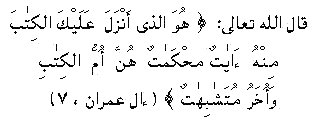
Surat Al-'Imran, ayah 7 means: Allah
 is the One Who has sent down to
the Prophet the Book that contains muhkamat ayat, which are the foundation of
the Book, and other ayat which are mutashabihat. So, know firmly, that
the Qur'an contains two types of ayat:
is the One Who has sent down to
the Prophet the Book that contains muhkamat ayat, which are the foundation of
the Book, and other ayat which are mutashabihat. So, know firmly, that
the Qur'an contains two types of ayat:
Muhkamat Ayaat
These are the ayat that have only one meaning according to the rules of the
Arabic language or else the meaning of the ayah is clearly known. Examples of
this type of ayat are: the saying of Allah , ta'ala: Surat ash-Shura, ayah 11
, ta'ala: Surat ash-Shura, ayah 11

means: There is nothing like Him and His saying, ta'ala:

Surat al-Ikhlas, ayah 4 means: There is nothing which is equal to Him,
and His saying, ta'ala:

Surat Maryam, ayah 65 means: Do you know of anything which is similar
to Him? There is none.
Mutashabihat Ayaat
These are the ayat that can have many meanings according to the rules of the
Arabic language. Assigning meanings to these ayat requires thorough thinking so
that acceptable meanings are given to them. Examples of this type of ayat are:
the saying of Allah
 , ta'ala, in Surat Taha, ayah 5:
, ta'ala, in Surat Taha, ayah 5:

and His saying, ta'ala, in Surat Fatir, ayah 10:

According to the rules of the Arabic language, these ayat are mutashabihat;
so they can have many meanings. If meanings are assigned to them, this must be
done in a manner that complies with the language and the Religion, and does not
contradict the ayat that are muhkamat.
Surely the ayat of the Qur'an do not
contradict one another.
Likewise, the aHadiith (sayings of the Prophet,
sallAllah
 u'alayhi wa sallam,) do not contradict one another, and they do not
contradict the ayat of the Qur'an.
u'alayhi wa sallam,) do not contradict one another, and they do not
contradict the ayat of the Qur'an.
There are two methodologies for explaining the mutashabihat ayat of the
Qur'an, and both of them are valid:
1) The Methodology of the Salaf:
2) The Methodology of the Khalaf:
The Methodology of the Salaf: The Salaf were the scholars who lived
during the first three centuries after the Hijrah of the Prophet, sallAllah
 u 'alayhi
wa sallam. For the most part, this methodology consisted of giving general
explanations, since the scholars of the Salaf believed that these ayat have
meanings befitting to the perfection of Allah
u 'alayhi
wa sallam. For the most part, this methodology consisted of giving general
explanations, since the scholars of the Salaf believed that these ayat have
meanings befitting to the perfection of Allah
 . Rather than saying what these
meanings are, they referred these mutashabihat ayat to the muhkamat ayat. A good
example is the saying of Imam ash-Shafi'I:
. Rather than saying what these
meanings are, they referred these mutashabihat ayat to the muhkamat ayat. A good
example is the saying of Imam ash-Shafi'I:
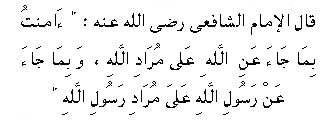
which means: "I believe in what Allah revealed according to the meaning
that Allah
revealed according to the meaning
that Allah willed, and in what the Messenger of Allah
willed, and in what the Messenger of Allah conveyed according to the
meaning that the Messenger of Allah
conveyed according to the
meaning that the Messenger of Allah willed."
willed."
In other words, the proper befitting meanings are not according to the
sensuous and physical meanings that delusions would lead to--such as places,
shapes, limbs, movements, sitting, colors, directions, smiling, laughter, or any
other meanings which are not permissible to be attributed to Allah . Furthermore,
the Arabs during these three centuries spoke the Arabic language with a natural
disposition and great eloquence. Their understanding of its meanings was so
sharp that they did not need to attribute specific meanings to the mutashabihat
ayat. Instead, they understood that these ayat have meanings that befit Allah
. Furthermore,
the Arabs during these three centuries spoke the Arabic language with a natural
disposition and great eloquence. Their understanding of its meanings was so
sharp that they did not need to attribute specific meanings to the mutashabihat
ayat. Instead, they understood that these ayat have meanings that befit Allah ,
and that it is impossible that they would have sensuous and physical meanings
that do not befit Allah
,
and that it is impossible that they would have sensuous and physical meanings
that do not befit Allah .
.
Nevertheless, it is well known that some of the scholars of the Salaf did
attribute specific meanings to mutashabihat ayat. In his Sahih, in the chapter
Tafsirul-Qur'an (the explanation of the Qur'an,) Imam al-Bukhari attributed a
specific meaning to the term "illa wajhahu" in Surat al-Qasas, ayah
88. He said, "illa mulkahu," i.e., he said that word "wajh"--which
is an attribute of Allah
 --means "Mulk" or "Dominion."
--means "Mulk" or "Dominion."

The Methodology of the Khalaf: The Khalaf were the scholars who lived
after the first threecenturies. For the most part, this methodology consisted of
giving specific meanings to the mutashabihat ayat. The scholars of the Khalaf
lived at a time when the people started to lose their natural disposition for
the Arabic language. Seeing that the people had become weaker in the language,
the scholars of the Khalaf feared that those with perversity in their hearts
would read meanings into the mutashabihat ayat that do not befit Allah . They
feared what is mentioned in Surat Al 'Imran, ayah 7. Allah
. They
feared what is mentioned in Surat Al 'Imran, ayah 7. Allah said:
said:

which means: Those who have perversity in their hearts, they follow
the mutashabihat ayat seeking discord and searching for unbefitting meanings
based on their delusions. In order to protect the creed of Islam, the
scholars of the Khalaf followed the example of those scholars among the Salaf
who chose to give specific meanings to the mutashabihat ayat. Referring them to
the muhkamat ayat, they gave specific meanings to the mutashabihat ayat in
compliance with the language and the Religion. They gave correct, acceptable
meanings to the mutashabihat ayat.

Allah
 said: Ayah 7 in Surat Al-'Imran means: No one knows their true
meanings except Allah
said: Ayah 7 in Surat Al-'Imran means: No one knows their true
meanings except Allah
 and those who are firmly rooted in the knowledge of the
Religion. The latter say, "We believe in it, all of it is from our
Lord" and none will understand the message except men of
comprehension."
and those who are firmly rooted in the knowledge of the
Religion. The latter say, "We believe in it, all of it is from our
Lord" and none will understand the message except men of
comprehension."
In relation to this ayah, Ibn 'abbas said: "I am one of those who are
firmly rooted in the knowledge of the Religion." It is well known that Ibn
'abbas is generally regarded as being foremost among the Companions in the
explanation of the meanings of the ayat of the Qur'an.
Among those who have perversity in their hearts are the mushabbihah, those
who liken Allah
 to His creation. The followers of Ibn Taymiyah and Muhammad Ibn
'abdil-Wahhab are among the group of the mushabbihah. They falsely claim that it
is prohibited to assign specific meanings to the mutashabihat ayat and
especially those that pertain to the attributes of Allah
to His creation. The followers of Ibn Taymiyah and Muhammad Ibn
'abdil-Wahhab are among the group of the mushabbihah. They falsely claim that it
is prohibited to assign specific meanings to the mutashabihat ayat and
especially those that pertain to the attributes of Allah
 . Moreover, they
innovated a devilish rule that assigning specific meanings to these ayat would
lead to cancelling these attributes of Allah
. Moreover, they
innovated a devilish rule that assigning specific meanings to these ayat would
lead to cancelling these attributes of Allah
 . This claim of theirs leads to
interpretations of the ayat of the Qur'an that contradict one another and
interpretations of the aHadiith of the Prophet that contradict one anotherand
contradict the ayat of the Qur'an. Furthermore, their claim accuses the Islamic
scholars among the Salaf and the Khalaf of blasphemy for denying the attributes
of Allah
. This claim of theirs leads to
interpretations of the ayat of the Qur'an that contradict one another and
interpretations of the aHadiith of the Prophet that contradict one anotherand
contradict the ayat of the Qur'an. Furthermore, their claim accuses the Islamic
scholars among the Salaf and the Khalaf of blasphemy for denying the attributes
of Allah
 . This would include: Ibn 'abbas, Sufyan ath-Thawri, Mujahid, Sa'Id Ibn
Jubayr, Malik, Ahmad, al-Bukhari, an-Nawawi, Ibn Rajab al-Hanbali, Ibn-ul-Jawzi,
Ibn Hajar, al-Bayhaqi, Abu Fadl at-Tamimi, 'abdul-Qahir al-Baghdadi, the
linguist and scholar of Hadiith Murtada az-Zabidi, and others.
. This would include: Ibn 'abbas, Sufyan ath-Thawri, Mujahid, Sa'Id Ibn
Jubayr, Malik, Ahmad, al-Bukhari, an-Nawawi, Ibn Rajab al-Hanbali, Ibn-ul-Jawzi,
Ibn Hajar, al-Bayhaqi, Abu Fadl at-Tamimi, 'abdul-Qahir al-Baghdadi, the
linguist and scholar of Hadiith Murtada az-Zabidi, and others.
Foremost, by this claim of theirs they are contradicting the Prophet
 .
Al-Bukhari related that the Prophet made a du'a' (a supplication) for Ibn 'abbas.
The Prophet said: .
Al-Bukhari related that the Prophet made a du'a' (a supplication) for Ibn 'abbas.
The Prophet said:
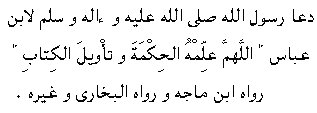
which means: O Allah
 , teach him the Knowledge of Hadiith and the
explanation of the Qur'an.
, teach him the Knowledge of Hadiith and the
explanation of the Qur'an.
In the chapter, Tafsir al-Qur'an, (Explanation of the meaning of the Qur'an),
Imam al-Bukhari says that the term wajhahu in Surat al-Qasas, ayah 88, means
"His Dominion." However, those mushabbihah who liken Allah
 to the
creation say, "We do not interpret, but rather we go by the literal
meaning," and hence (they say) wajhahu means "His face."
to the
creation say, "We do not interpret, but rather we go by the literal
meaning," and hence (they say) wajhahu means "His face."
Ibn Hajar al-'asqalani, in his book, Al-Fath (an explanation of the
meaning of Sahih al-Bukhari), Volume 6, page 39-40, said: " ..... in
reference to al-Bukhari's saying that the attribute of Allah
 , ad-dahik, means
'mercy,' it is closer to say that it means 'acceptance of deeds.'
, ad-dahik, means
'mercy,' it is closer to say that it means 'acceptance of deeds.'
Yet, the mushabbihah insist on taking the literal meaning, and they say that
Allah
 smiles, or laughs.
smiles, or laughs.
In Surat al-Qalam, ayah 42, Allah
 said:
said:

The scholars of the Salaf explained the term saq by 'hardship,' and the ayah
to mean 'a day of anguish and hardship.' This explanation is known to have been
given by Ibn 'abbas, Mujahid, Ibrahim an Nakh'I, Qatadah, Sa'Id Ibn Jubayr, and
a multiple of scholars. Both Imam al-Fakhr ar-Razi in his Explanation of the
Qur'an, Volume 30, page 94 and Imam al-Bayhaqi in his books, Al-'asma' was-Sifat,
(page 245) and Fath-al-Bari, (Volume;13, page 428) related this
explanation from Ibn 'abbas. Ibn Qulayb also related that about Sa'Id Ibn Jubayr
who took his knowledge from 'abdullah Ibn 'abbas and Ibn 'Umar. Yet, the
mushabbihah insist on taking the literal meaning and attribute 'the shin' to
Allah
 , by saying saq literally means 'shin.'
, by saying saq literally means 'shin.'
In Surat-ul-Baqarah, ayah 115, Allah
 said:
said:

Imam Mujahid, the student of Ibn 'abbas, said that the word wajh means 'Qiblah,'
i.e., the direction of prayers during the voluntary prayers while travelling and
riding on an animal. Yet, the mushabbihah insist on taking the literal meaning;
they say the term, wajh, means 'face.'
Similarly, if ayah 12 in Surat at-Tahrim:

was taken literally, it would mean that Allah
 blew part of His Soul into 'Isa
(Jesus.) However, the scholars said that this ayah means: Allah
blew part of His Soul into 'Isa
(Jesus.) However, the scholars said that this ayah means: Allah
 ordered
Jibril to blow into 'Isa the soul which is honorable to Allah
ordered
Jibril to blow into 'Isa the soul which is honorable to Allah
 .
.
Also, ayah 75 in Surat Sad:
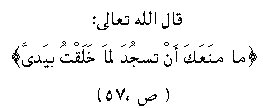
if taken literally, would mean: "What has stopped you from performing
sujud to what I have created with My hands?" However, the scholars said
that the word 'yadayn' in the ayah means the 'care' of Allah
 . Yet, the
mushabbihah insist that yadayn means hands.
. Yet, the
mushabbihah insist that yadayn means hands.
Likewise, ayah 35 in Surat an-Nur:

if taken literally, would mean: "Allah
 is the light of the heavens and
the Earth." The scholars said that this ayah means: Allah
is the light of the heavens and
the Earth." The scholars said that this ayah means: Allah
 is the
Creator of guidance in the occupants of the skies and the occupants of the
earth. However, the mushabbihah insist on taking the literal meaning
and say that Allah
is the
Creator of guidance in the occupants of the skies and the occupants of the
earth. However, the mushabbihah insist on taking the literal meaning
and say that Allah
 is 'light.'
is 'light.'
If taken literally, ayah 22 in Surat al-Fajr:

would mean: "Your Lord comes." It was related that Imam Ahmad Ibn
Hanbal, who is among the authorities of the Salaf, said that this ayah means: An
indication of the Power of Allah
 has come.
has come.
In his book, Manaqib Ahmad, Hafidh Imam al-Bayhaqi, established that
the sanad (chain) of narrators is sahih (authentic). Also, Ibn al-Jawzi al-Hanbali,
one of the authorities of the school of Imam Ahmad, related that Imam Ahmad
assigned specific, acceptable meanings to the ayat which are mutashabihat. He
also said this is a proof that Imam Ahmad did not believe that the maji'ah (a
noun for the verb ja'a) in the ayah is that of movement from one place to
another.
Imam Ibn al-Jawzi also said: "It is not possible that Allah
 would
move." Yet, the mushabbihah insist on taking the literal meaning and say
that ja'a means "Your Lord comes" (i.e., from one place to another.)
would
move." Yet, the mushabbihah insist on taking the literal meaning and say
that ja'a means "Your Lord comes" (i.e., from one place to another.)
The Hadiith of the Prophet
 related by al-Bukhari was explained and affirmed by Imam Malik: related by al-Bukhari was explained and affirmed by Imam Malik:

as a descent of mercy and not that of movement. However, the mushabbihah
insist on taking the literal meaning and they say the nuzul in the Hadiith means
a descent of movement and going from one place to another.
Copying from Imam al-'ash'ari, Imam al-Bayhaqi, in his book, Al-Asma' was-Sifat,
page 488, said: "Allah
 , ta'ala, is not in a place. Movement, coming to
rest, and sitting are among the attributes of bodies."
, ta'ala, is not in a place. Movement, coming to
rest, and sitting are among the attributes of bodies."
Imam Ibn Rajab al-Hanbali explained the term al-istiwa', in Surat Taha, ayah
5:

as al-istila', which means subjugating. When al-istila' is used to explain
this ayah it means that Allah
 subjugated the 'arsh with a subjugation that is
without a beginning, like all of the attributes of Allah
subjugated the 'arsh with a subjugation that is
without a beginning, like all of the attributes of Allah
 . If the ayah is
explained in this manner, it means that Allah
. If the ayah is
explained in this manner, it means that Allah
 was attributed with subjugating
the 'arsh before the 'arsh was created in the same way that Allah
was attributed with subjugating
the 'arsh before the 'arsh was created in the same way that Allah
 was attributed
with being the Creator before anything from the creation existed. In this
context, the scholars have used the term al-azal, which means the status of
existing without a beginning. Thus it can be said that Allah
was attributed
with being the Creator before anything from the creation existed. In this
context, the scholars have used the term al-azal, which means the status of
existing without a beginning. Thus it can be said that Allah
 subjugated the 'arsh
in al-azal, meaning that Allah
subjugated the 'arsh
in al-azal, meaning that Allah
 subjugated the 'arsh with a subjugation which is
without a beginning. Yet the mushabbihah insist on taking the literal meaning,
and they say istiwa' means Allah
subjugated the 'arsh with a subjugation which is
without a beginning. Yet the mushabbihah insist on taking the literal meaning,
and they say istiwa' means Allah
 'sits' on the throne and 'firmly establishes'
Himself on it.
'sits' on the throne and 'firmly establishes'
Himself on it.
In his book, Al-Mu'taqad, Imam al-Bayhaqi related in a chain back to
al-'awza'I and Imam Malik and Sufyan ath-Thawri and al-Layth Ibn Sa'd that when
they were asked about the ayat and the aHadiith that are mutashabihat, they said:

which means: "Accept them as they came without applying a 'how' to
them." This is because if one asked the question 'how?' the answer would
be, 'Like this or that.' Everything other than Allah
 is His creation so to say
'like this or that' would mean 'like this or that created thing' and Allah
is His creation so to say
'like this or that' would mean 'like this or that created thing' and Allah
 is
not like His creation. Anything a person can imagine, Allah
is
not like His creation. Anything a person can imagine, Allah
 is different from
it. When the scholars said: "...without applying a 'how' to them,"
they meant that Allah
is different from
it. When the scholars said: "...without applying a 'how' to them,"
they meant that Allah
 is clear of being attributed with sitting, resting,
moving, limbs, bodies, and parts. They did not mean that His istiwa' over the
throne has a 'how' of which we are ignorant. On the contrary, the scholars
completely negated that a 'how' could be applied to Allah
is clear of being attributed with sitting, resting,
moving, limbs, bodies, and parts. They did not mean that His istiwa' over the
throne has a 'how' of which we are ignorant. On the contrary, the scholars
completely negated that a 'how' could be applied to Allah
 . So the statement of
those who say,
. So the statement of
those who say,
"Allah
 sits on the throne but we do not know how," is rejected on
the basis of what these scholars said.
sits on the throne but we do not know how," is rejected on
the basis of what these scholars said.
Anyone with a sound mind knows that sitting, no matter how it is, is an
attribute of bodies. Occupying places necessitates a 'how' and applies to
bodies. Furthermore, color and touching are attributes of bodies and 'how'
applies to them. All of that is impossible to apply to Allah
 .
.
Similarly, when the Prophet
 asked the black slave woman the question: "AynAllah asked the black slave woman the question: "AynAllah
 ?", the scholars
said this meant he was asking her about her belief in the status ofAllah
?", the scholars
said this meant he was asking her about her belief in the status ofAllah
 . She
answered: "Fis-sama'" which has the meaning that Allah
. She
answered: "Fis-sama'" which has the meaning that Allah
 has the highest
status. Yet the mushabbihah insist on taking the literal meaning--saying that
the Prophet asked her about the place of Allah
has the highest
status. Yet the mushabbihah insist on taking the literal meaning--saying that
the Prophet asked her about the place of Allah
 , and that she said, "In the
sky," meaning that the sky is a place for Allah
, and that she said, "In the
sky," meaning that the sky is a place for Allah
 . Likewise, the Hadiith of
the Prophet, sallAllah
. Likewise, the Hadiith of
the Prophet, sallAllah
 u 'alayhi wa sallam:
u 'alayhi wa sallam:
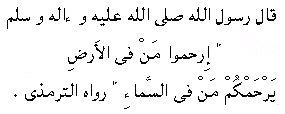
means: If you are merciful to those on earth, the angels, who occupy the
heavens, will bring onto you the mercy of Allah
 . Yet, the mushabbihah insist
on taking the literal meaning--saying the Hadiith means: "Allah
. Yet, the mushabbihah insist
on taking the literal meaning--saying the Hadiith means: "Allah
 , Who
occupies the heavens, will be merciful to you."
, Who
occupies the heavens, will be merciful to you."
So the mushabbihah insist on taking the literal meanings of the mutashabihat
ayat. They reject assigning specific meanings to them, and they refuse to
ascribe acceptable meanings to them. By doing this, they render the ayat of the
Qur'an and the aHadiith in contradiction to one another. For example, the famous
Hadiith of the Prophet:
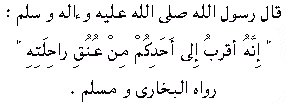
if taken by the method of the mushabbihah, it would mean, "Allah
 is
between the person and the neck of his animal." This is in direct
contradiction with their claim that the Hadiith of the black slave woman means:
"Allah
is
between the person and the neck of his animal." This is in direct
contradiction with their claim that the Hadiith of the black slave woman means:
"Allah
 has a place, which is the sky."
has a place, which is the sky."
Likewise, if ayah 4 in Surat al-Hadid:

is taken literally, it would mean, "Allah
 is with you, wherever you
are." However, the scholars established that this ayah means: Allah
is with you, wherever you
are." However, the scholars established that this ayah means: Allah
 knows about you, wherever you are. Similarly, if the saying of Allah
knows about you, wherever you are. Similarly, if the saying of Allah
 in
Surat Fussilat, ayah 54:
in
Surat Fussilat, ayah 54:

if taken by its literal meaning, it would mean, "Allah
 surrounds
everything." Furthermore, if the saying of Allah
surrounds
everything." Furthermore, if the saying of Allah
 that Ibrahim said in Surat
as-Saffat, ayah 99:
that Ibrahim said in Surat
as-Saffat, ayah 99:

is taken by its literal meaning, it would mean, "Allah
 is in the
countries of ash-Sham," since this ayah was related about Sayyidina Ibrahim
while he was moving from Iraq to the countries of ash-Sham.
is in the
countries of ash-Sham," since this ayah was related about Sayyidina Ibrahim
while he was moving from Iraq to the countries of ash-Sham.
If the saying of Allah
 in Surat al Baqarah, ayah 125:
in Surat al Baqarah, ayah 125:

is taken by its literal meaning, it would mean: "The Ka'bah is the
residence of Allah
 ." If ayah 128 in Surat an-Nahl is taken literally, it
would mean, "Allah
." If ayah 128 in Surat an-Nahl is taken literally, it
would mean, "Allah
 is physically with the pious." ar that if these
ayat are interpreted based on the literal meanings, this will lead to numerous
contradictions. The great scholars of Islam have ascribed proper and acceptable
meanings to the mutashabihat ayat and the mutashabihat aHadiith in accordance
with the Religion, the language, and by referring them to the clear muhkamat
ayat. They said Surat al-Hadid, ayah 4,
is physically with the pious." ar that if these
ayat are interpreted based on the literal meanings, this will lead to numerous
contradictions. The great scholars of Islam have ascribed proper and acceptable
meanings to the mutashabihat ayat and the mutashabihat aHadiith in accordance
with the Religion, the language, and by referring them to the clear muhkamat
ayat. They said Surat al-Hadid, ayah 4,

means: Allah
 knows about you wherever you are. Surat
Fussilat, ayah 54,
knows about you wherever you are. Surat
Fussilat, ayah 54,

means Allah
 knows everything. Surat al-Baqarah, ayah 125,
knows everything. Surat al-Baqarah, ayah 125,

means: The Ka'bah is a house of a great honor to Allah
 .
Surat al-An'am, ayah 61,
.
Surat al-An'am, ayah 61,

refers to the fawqiah (aboveness) of subjugation, meaning: All are
subjugated to Allah
 .
.
Surat an-Nahl, ayah 128,

means: Allah
 supports those who are pious. Surat Taha, ayah
5,
supports those who are pious. Surat Taha, ayah
5,

means: Allah
 subjugated the 'arsh in al-azal with a subjugation which
is without a beginning, like all of the attributes of Allah
subjugated the 'arsh in al-azal with a subjugation which
is without a beginning, like all of the attributes of Allah
 .
.
In taking the mutashabihat ayat by their literal meanings, the mushabbihah
contradict the muhkamat ayat, like Surat ash-Shura, ayah 11,

which means: There is nothing like Allah
 . They try to escape
the contradiction by camouflaging it, saying that Allah
. They try to escape
the contradiction by camouflaging it, saying that Allah
 has a 'face' but without
countenance; and Allah
has a 'face' but without
countenance; and Allah
 has a 'direction' which is above, but we do not know
'how' it is; and Allah
has a 'direction' which is above, but we do not know
'how' it is; and Allah
 has a 'shin,' but we do not know 'how' His 'shin' is.
has a 'shin,' but we do not know 'how' His 'shin' is.
Moreover, they say that Allah
 'sits' but we do not know 'how' His 'sitting'
is.
'sits' but we do not know 'how' His 'sitting'
is.
The great Hanafi linguist and scholar of Hadiith, Imam Murtada az-Zabidi, in
his book, Ithafus-Sadatil-Muttaqin, refuted those who reject acceptable
meanings be assigned to the ayat which are mutashabihat and insist on taking
them by their literal meanings. He said: "In essence they are slandering
the office of Prophethood; they are claiming that the Prophet did not know the
meaning of the attributes of Allah
 that were revealed to him; and they are
claiming he called the creation to believe in that of which he was
ignorant." However, Allah
that were revealed to him; and they are
claiming he called the creation to believe in that of which he was
ignorant." However, Allah
 says in the Qur'an in Surat ash-Shu'ara', ayah
195:
says in the Qur'an in Surat ash-Shu'ara', ayah
195:

which means: The Qur'an was revealed in clear, explicit Arabic.
Az-Zabidi proceeded to say: "Those people who take a position against
assigning acceptable meanings are basically likening Allah
 to the
creation." However, they camouflage it by saying that he has a 'hand,' not
like the hands of the creation and a 'shin' not like the shins of creation and a
physical istiwa', that we cannot comprehend. He addressed them with: "Your
saying, 'we take it by its literal meaning and it is incomprehensible' is
contradictory in itself. If you take by its literal meaning, then 'as-saq' in
Surat al-Qalam, ayah 42, is a 'shin' which is a part made up of flesh, bones,
muscle, and nerves. If you take by that literal meaning, then you have committed
blasphemy, and if you deny it, then how do you claim to take by the literal
meaning?"
to the
creation." However, they camouflage it by saying that he has a 'hand,' not
like the hands of the creation and a 'shin' not like the shins of creation and a
physical istiwa', that we cannot comprehend. He addressed them with: "Your
saying, 'we take it by its literal meaning and it is incomprehensible' is
contradictory in itself. If you take by its literal meaning, then 'as-saq' in
Surat al-Qalam, ayah 42, is a 'shin' which is a part made up of flesh, bones,
muscle, and nerves. If you take by that literal meaning, then you have committed
blasphemy, and if you deny it, then how do you claim to take by the literal
meaning?"
Rest assured that the methodologies of both the Salaf and the Khalaf are
correct and neither of them attribute anything to Allah
 that does not befit Him.
In simple terms, one correct way of explaining the mutashabihat ayat in the
Qur'an is to say one believes in them according to the meaning that Allah
that does not befit Him.
In simple terms, one correct way of explaining the mutashabihat ayat in the
Qur'an is to say one believes in them according to the meaning that Allah
 willed
without saying what that meaning is; and without a 'how,' i.e., without
attributing to Allah
willed
without saying what that meaning is; and without a 'how,' i.e., without
attributing to Allah
 sitting, standing, occupying places, sensuous attributes,
or any of the meanings that apply to humans and other creations. Following this
method, one would say: "Allah
sitting, standing, occupying places, sensuous attributes,
or any of the meanings that apply to humans and other creations. Following this
method, one would say: "Allah
 has an istiwa' which befits Him--which is not
sitting, and Allah
has an istiwa' which befits Him--which is not
sitting, and Allah
 has a yad which befits Him--which is not a hand, and a wajh
that befits Him--which is not a face." The second correct way of explaining
the mutashabihat ayat in the Qur'an is to give specific meanings to them which
are in accordance with the Religion and the language. Following this method, one
would say: "His istiwa' means 'He preserves the throne,' His yad means 'His
Care,' His wajh means 'His Self,' 'His Dominion,' or 'His Qiblah.'"
has a yad which befits Him--which is not a hand, and a wajh
that befits Him--which is not a face." The second correct way of explaining
the mutashabihat ayat in the Qur'an is to give specific meanings to them which
are in accordance with the Religion and the language. Following this method, one
would say: "His istiwa' means 'He preserves the throne,' His yad means 'His
Care,' His wajh means 'His Self,' 'His Dominion,' or 'His Qiblah.'"
Also know that among the mutashabih are things that only Allah
 knows about,
such as the time when the Day of Judgment will occur, the exact day the sun will
rise from its setting place, the exact time when the Dajjal would appear, and
the like. This falls under one of the meanings of Surat Al-'Imran, ayah 7:
knows about,
such as the time when the Day of Judgment will occur, the exact day the sun will
rise from its setting place, the exact time when the Dajjal would appear, and
the like. This falls under one of the meanings of Surat Al-'Imran, ayah 7:
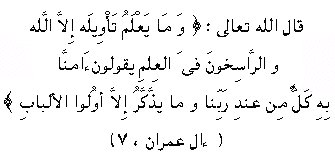
which means: No one knows the meaning of that kind of mutashabih
except Allah
 .
.
May Allah
 protect us from falling into the trap of likening Allah
protect us from falling into the trap of likening Allah
 to His
creation. Imam Abu Ja'far at-Tahawi, in his book Al-'aqidatut-Tahawiyyah,
said:
to His
creation. Imam Abu Ja'far at-Tahawi, in his book Al-'aqidatut-Tahawiyyah,
said:

which means: "Whoever attributes to Allah
 any of the meanings pertaining
to humans commits blasphemy."
any of the meanings pertaining
to humans commits blasphemy."
We ask Allah
 to keep us steadfast on the correct path and creed of the
Islamic scholars among the Salaf and the Khalaf. We seek refuge with Allah
to keep us steadfast on the correct path and creed of the
Islamic scholars among the Salaf and the Khalaf. We seek refuge with Allah
 from
falling into the trap of apostasy, because the Prophet, sallAllah
from
falling into the trap of apostasy, because the Prophet, sallAllah
 u 'alayhi wa
sallam, said in the Hadiith related by at-Tirmidhi:
u 'alayhi wa
sallam, said in the Hadiith related by at-Tirmidhi:
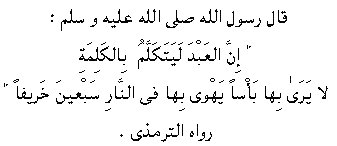
This means: The slave shall utter with a word he does not see harmful that
will cause him to fall into Hellfire for seventy autumns. This is a place
that only the kuffar will reach.
Be extremely observant of what you utter, for Allah
 , ta'ala said in Surat Qaf,
ayah 18 :
, ta'ala said in Surat Qaf,
ayah 18 :
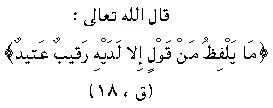
which means: Every word that a person utters will be written down by
the two angels, Raqib and 'atid.
Also, beware of books that are claimed to be interpretations of the Qur'an or
translations of its meanings and in which they liken Allah
 , the Exalted, to His
creation, by attributing to Him light, hands, eyes, shins, faces, sitting,
directions, places, and the like. Allah
, the Exalted, to His
creation, by attributing to Him light, hands, eyes, shins, faces, sitting,
directions, places, and the like. Allah
 is clear of all imperfection and of any
resemblance to the creation.
is clear of all imperfection and of any
resemblance to the creation.
Praise be to Allah
 the Lord of the Worlds, the One Who is clear of resembling
the creation, all non-befitting attributes, and all which the blasphemers
unrightfully say about Him.
the Lord of the Worlds, the One Who is clear of resembling
the creation, all non-befitting attributes, and all which the blasphemers
unrightfully say about Him.
Here muhkamaat and mutashabihat are
described as follows:
muhkama:
-
Something of which knowledge was desired.
-
Something with only one dimension.
-
Something sufflcient in meaning, requiring no
further explanation.
mutashabihat:
-
Something known to Allah only.
-
Something with more than one dimension.
-
Something requiring further explanation.
Hence in the Qur'an those ayat dealing with halal and
haram, punishments, inheritance, promise and threat,
etc.belong to the muhkamaat, while those concerning
the attributes of Allah, the true nature of the resurrection,
judgement and life after death etc. belong to the
mutashabihat.
General
and Specific
Some verses of the Qur'an are of a very wide, general
application (al-'am), e.g. including all human beings, or
all Muslims etc. Other ayat are restricted in their
application to certain special circumstances only (al-khas).
Example:
'Every soul shall have a taste of
death' (Al-Qur'an 3: 185)
'Let there be no obscenity, nor
wickedness nor wrangling in the Hajj' (Al-Qur'an 2:187).
'God (thus) directs you as
regards your children (inheritance)' (Al-Qur'an 4: 11).
Furthermore one also distinguishes between 'general
verses' which remain general, and others which intend a
specific meaning.
Example:
'Pilgrimage thereto is a duty man
owes to God- those who can afford the journey'
(Al-Qur'an 3: 97).
Of the 'special meanings' there are several varieties.
Usually some kind of condition or limitation is specified.
Example:
'Your step-daughters under your
guardianship, born of your wives to whom you have gone
in' (Al-Qur'an 4: 23).
'It is prescribed when death
approaches any one of you, if you leave any goods that
he make a bequest to parents and next of kin' (Al-Qur'an
2: 180).
'So keep away from the women in
their courses, and do not approach them until they are
clean' (Al-Qur'an 2: 222).
'Free' and 'Bound' Verses
Some of the ahkam verses are valid, 'free' (mutlaq)
from any conditions or circumstances, while others are 'bound'
(muqayyad) to special conditions or situations, and
apply only therein.
Examples:
'If it is beyond your means, fast
for three days, that is expiation for the wrath ye have
sworn' (Al-Qur'an 5: 92).
It is free, i.e. left to one's discretion whether to fast
three days consecutively or with interruptions.
'And if ye find no water then
take yourselves clean sand or earth and rub therewith
your faces and hands' (Al-Qur'an 5: 6).[Some
say this aya is 'bound', as the same aya mentioning
wudu' instructs washing of the hands 'to the elbows';
others say it is 'free'.]
'Literal' and
'Understood' Meanings
The meaning of certain ayat is derived from the literal
wording (mantdq) while that of others is derived from what
is understood (mafhum) by them:
Of the literal understanding there are several kinds. The
first concerns a clear text, i.e. a text clear and without
ambiguity.
Example:
'But if he cannot afford it, he
should fast three days during the Hajj and seven days on
his return, making ten days in all' Al-Qur'an 2: 196).
In other cases the text may be somewhat ambiguous in its
expression but obvious as far as the meaning is concerned.
Example:
'And do not approach them until
they are clean' (Al-Qur'an 2: 222).
The Arabic word tatahharna may refer to the end of the
woman's menstrual period, or the completion of the bath
after the period; the second being more obvious. [Qattan, M.: mabahith
It 'ulum al-qur'an, Riyadh. 1971.]
Still other verses imply a meaning through the context,
although the wording itself is not clear.
Example:
'And out of kindness reward to
them the wing of humility' (Al-Qur'an 17: 24).
This applies to parents, and not to all human beings in
general, as the context of this verse suggests.
Al Muqatta'at
The so-called 'abbreviated letters' are an important
section of the mutashabihat'
[Itqan, II, p.8f. A summary of the orientalists' efforts on
this topic is in Jeffery. Arthur: The Mystic Letters of the
Quran, MW, 14 (1924), pp. 247-60. Some of the orientalists
suggested that the letters are abbreviations of the names of
the various Companions who used to write the Qur'an for
Muhammad. Still others say that the letters are simply
symbols employed to distinguish the Sura from others before
the now common names were introduced. Sura Ta Ha would be a
case in point. This is also based on some Muslim scholars'
views (Itqan, 11, p.10). Watt, the Edinburgh
priest-orientalist, writes 'We end where we began; the
letters are mysterious, and have so far baMed interpretation'
(Watt, M.: Bell's Introduction to the Qur'an, Edinburgh,
1977, p.64).] insofar as their meanings are not
known.The word is derived from the root 'qata'a' - to cut,
and means 'what is cut', and also 'what is abbreviated'.
In technical language the word is used for certain
letters found at the beginning of several suras of the
Qur'an, called 'the abbreviated letters'.
Their
Occurrence
There are fourteen such letters occurring in various
combinations at the beginning of 29 suras. The
following is a list of their occurrence and distribution in
the Qur'an:
Alif Lam Ra: 10, 11, 12, 14, 15.
Alif Lam Mim: 2, 3, 29, 30, 31, 32.
Alif Lam Mim Ra': 13.
Alif Lam Mim Sad: 7
Ha Mim: 40, 41, 43, 44, 45, 46.
Sad: 38.
Ta Sin: 27.
Ta Sin Mim: 26, 28.
TaHa:20.
Qaf: 50.
Kaf Ha Ya 'Ain Sad: 19.
Nun: 68.
Ya Sin: 36.
Variety of Explanations
The meaning and purpose of these letters is uncertain.
There have been a variety of explanations offered by Muslim
scholars throughout the ages. Among them are:
[See itqan, 11, pp.9-11.]
These letters might be abbreviations for certain sentences
and words, such as e.g. Alif Lam Mim meaning Ana llahu
A'lam; or Nun meaning Nur (light), etc. These letters are
not abbreviations but symbols and names of Allah, or
something else.
[e .g. the
letter nun standing for 'fish' . which occurs in every sura
that has nun as 'abbreviated letter' in front, or ta
standing for snake, as every sura with [a as abbreviated
letterw in front contains the story of Musa and the snake.]
These letters have some numerical significance, as the
semitic letters also have numerical value. These letters
were used to attract the attention of the Prophet (and later
his audience) for the revelation to follow.
There are also many other explanations which cannot be
referred to here. The 'abbreviated letters' are part of the
Qur'anic message, revealed to the Prophet Muhammad and
therefore included in the text of the Qur'an. They are to be
recited and read as part of the suras where they occur. They
are a good example for one kind of mutashabihdt which is
referred to in the Qur'an itself, (3: 7), the meaning of
which is known to Allah. The Qur'an says of them: '... these
are the symbols of the perspicuous book' (12: 1).
|
![]()
![]()